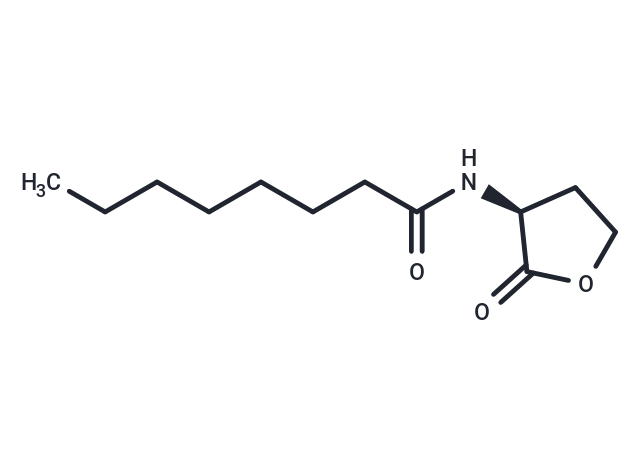Shopping Cart
Remove All Your shopping cart is currently empty
Your shopping cart is currently empty
N-octanoyl-L-Homoserine lactone (C8-HSL) is a diffusible exogenous Yersinia pestis population-sensing molecule that modulates LcrV virulence factors, controls gene expression by participating in population sensing, and affects cellular metabolism.N-octanoyl-L-Homoserine lactone is used to study cystic fiber Infection.

| Pack Size | Price | USA Warehouse | Global Warehouse | Quantity |
|---|---|---|---|---|
| 5 mg | $39 | In Stock | In Stock | |
| 10 mg | $72 | In Stock | In Stock | |
| 25 mg | $155 | In Stock | In Stock | |
| 50 mg | $263 | In Stock | In Stock | |
| 100 mg | $393 | - | In Stock | |
| 500 mg | $888 | - | In Stock | |
| 1 mL x 10 mM (in DMSO) | $43 | In Stock | In Stock |
| Description | N-octanoyl-L-Homoserine lactone (C8-HSL) is a diffusible exogenous Yersinia pestis population-sensing molecule that modulates LcrV virulence factors, controls gene expression by participating in population sensing, and affects cellular metabolism.N-octanoyl-L-Homoserine lactone is used to study cystic fiber Infection. |
| Synonyms | OHL, N-octanoyl-L-Homoserine lactone, C8-HSL |
| Molecular Weight | 227.3 |
| Formula | C12H21NO3 |
| Cas No. | 147852-84-4 |
| Smiles | CCCCCCCC(=O)N[C@H]1CCOC1=O |
| Sequence | octanoyl-Hsl |
| Storage | Powder: -20°C for 3 years | In solvent: -80°C for 1 year | Shipping with blue ice/Shipping at ambient temperature. | ||||||||||||||||||||||||||||||||||||||||
| Solubility Information | DMSO: 125 mg/mL (549.93 mM), Sonication is recommended. DMF: 20 mg/mL (87.99 mM), Sonication is recommended. | ||||||||||||||||||||||||||||||||||||||||
| In Vivo Formulation | 10% DMSO+90% Corn Oil: 2.5 mg/mL (11 mM), Sonication is recommeded. Please add the solvents sequentially, clarifying the solution as much as possible before adding the next one. Dissolve by heating and/or sonication if necessary. Working solution is recommended to be prepared and used immediately. The formulation provided above is for reference purposes only. In vivo formulations may vary and should be modified based on specific experimental conditions. | ||||||||||||||||||||||||||||||||||||||||
Solution Preparation Table | |||||||||||||||||||||||||||||||||||||||||
DMF/DMSO
DMSO
| |||||||||||||||||||||||||||||||||||||||||
| Size | Quantity | Unit Price | Amount | Operation |
|---|

Copyright © 2015-2026 TargetMol Chemicals Inc. All Rights Reserved.